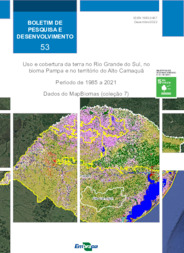Uso e cobertura da terra no Rio Grande do Sul, no bioma Pampa e no território do Alto Camaquã: período de 1985 a 2021: dados do MapBiomas (coleção 7).
Uso e cobertura da terra no Rio Grande do Sul, no bioma Pampa e no território do Alto Camaquã: período de 1985 a 2021: dados do MapBiomas (coleção 7).
Author(s): ROCHA, D. S. da; TRINDADE, J. P. P.; VOLK, L. B. da S.
Summary: O monitoramento do perfil da vegetação natural na região dos Campos Sulinos do Rio Grande do Sul já faz parte das atividades que visam observar o comportamento e a dinâmica espaço-temporal que ocorrem no uso e cobertura da terra e que afetam a atividade pecuária. No contexto de produção ecologicamente sustentável, economicamente viável e socialmente justa, as variáveis que regulam esta dinâmica precisam ser monitoradas e acompanhadas para que se possa entender os processos que as determinam, bem como seus impactos. O objetivo do trabalho é apresentar a série histórica das classes de uso e cobertura da terra, proposta e disponibilizada pelo Projeto MapBiomas, nas escalas do estado do Rio Grande do Sul, do bioma Pampa e do território do Alto Camaquã no período de 1985 a 2021 e discutir a relação entre as classes de mapeamento levando em conta as particularidades existentes nas três escalas de observação. Land use and land cover in Rio Grande do Sul, Pampa biome and Alto Camaquã territory. Period from 1985 to 2021 - MapBiomas Data (Collection 7) Abstract ? Monitoring the profile of natural vegetation in the Campos Sulinos region of Rio Grande do Sul is already part of the activities that aim to observe the behavior and spatio-temporal dynamics that occur in land use and cover and that affect livestock activity. In the context of ecologically sustainable, economically viable and socially fair production, the variables that regulate this dynamic need to be monitored and followed up in order to understand the processes that determine them, as well as their impacts. The objective of this work is to present the historical series of land use and land cover classes, proposed and made available by the MapBiomas Project, at the scales of the Rio Grande do Sul state, the Pampa biome and the Alto Camaquã territory, from 1985 to 2021 and discuss the relationship between the mapping classes taking into account the particularities existing in the three observation scales. The percentual data of each land use class were extracted from MapBiomas, with the help of the Semi Automatic Classification Plugin (SCP) that is run within the QGIS software. In general terms, the regions of the Alto Camaquã territory, the Pampa biome and the state of RS show similar trends in the dynamics of land use change in relation to the same classes. However, there are different local and regional factors that limit or enhance the spatial and temporal dynamics of different land uses, such as soil groups, terrain slope and public policies, making the geospatial distribution of changes is neither uniform nor constrained by political divisions. It is evident the increase in the areas of Soybean and Temporary Crops (from the year 2000) and Silviculture (from the year 2004) throughout the state of RS, which includes the Pampa biome and Alto Camaquã region, to the detriment of others land uses. However, such substitution was different among the three scales considered, based on temporal dynamics. The region of the Alto Camaquã territory is still one of the regions in the state of RS and in the Pampa biome with the highest percentage of coverage with grassland vegetation.
Publication year: 2022
Types of publication: Booklets
Observation
Some of Embrapa's publications are published as ePub files. To read them, use or download one of the following free software options to your computer or mobile device. Android: Google Play Books; IOS: iBooks; Windows and Linux: Calibre.
Access other publications
Access the Agricultural Research Database (BDPA) to consult Embrapa's full library collection and records.
Visit Embrapa Bookstore to purchase books and other publications sold by Embrapa.

